Are you a Quiet Speculation member?
If not, now is a perfect time to join up! Our powerful tools, breaking-news analysis, and exclusive Discord channel will make sure you stay up to date and ahead of the curve.
You can't play Modern without hearing about the "Bolt Test". If a card or deck is soft to the format's most efficient removal spell, then it might not be a good choice for Modern. The Bolt Test is a big reason otherwise decent creatures, like Figure of Destiny or Vampire Nighthawk, don't really see Modern play. It is one of the reasons for Twin's continual dominance, a deck-maker in Jund, Grixis Delver, and UWR Midrange/Control, and the workhorse of Modern Burn. It is also the reason Lightning Strike is the new face of Standard-legal burn (because those T2 mages couldn't take the heat!). When it comes to efficient damage, it doesn't get any better than the Alpha original. But as Modern has evolved, Lightning Bolt's fortunes have risen and fallen in turn. And at times, this has led Modern players to wonder if Bolt is always as good or important as we are led to believe.
There was a time in Modern when you couldn't question Bolt's value. But once BGx went the way of Abzan instead of the traditional path of Jund, it was hard to not doubt Bolt's necessity. But just when you thought the issue might be decided, we see the continual dominance of the Bolt-backed Twin, as well as the return of Delver (Grixis style) to the scene. We also saw a huge rise in Infect, a deck that was particularly successful in a Boltless metagame. None of this is to tell us whether Bolt is good or bad. It's just to show how complicated the question can become, especially for deckbuilders. This article tries to address the problem in two ways. First, I propose some theoretical frameworks you can use to evaluate Bolt's effectiveness. Second, I create a quantitative system around those frameworks, giving some data-driven suggestions about Bolt's effectiveness today. In the end, this article will give you some more tools to help understand when Bolt matters and when you can ignore it. This is important both as for players who might want to use Bolt, and for those who might want to pilot a deck with Bolt weaknesses.
[wp_ad_camp_1]
When Is Bolt Good?
Before we get to the quantitative stuff, I want us to think about the theory behind Bolt's strengths. Questioning Bolt's significance in Modern feels wrong, kind of like questioning Led Zeppelin's importance in the history of rock. But to understand when Bolt might not be the best choice, we need to first understand why it is so good.
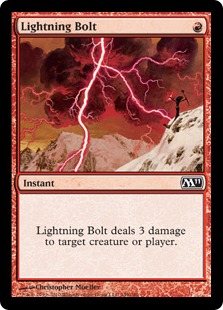 To start, it's not enough to say "Bolt is good because it is Modern's most efficient removal spell." For one, this gets us in shaky terminological territory because "most efficient" sounds synonymous with "best". It's like saying Bolt is the best removal spell in Modern because, well...it's the best removal spell in Modern! So that answer alone doesn't get us very far. Moreover, this statement is not even always true. There are tons of threats Bolt can't "remove" one-for-one: Goyf, Exarch, Rhino, Tasigur, Etched Champion, Resto Angel, Geist, and an endless list of creatures who have endured specifically because they passed the Bolt test. There are also many cards Bolt kills but definitely not "efficiently", like Spirit/Faerie/Soldier tokens, Kitchen Finks, Voice of Resurgence, etc. So even if we do define "most efficient removal" as a term, we are still leaving ourselves in a situation where Bolt has glaring weaknesses not covered in "most efficient removal".
To start, it's not enough to say "Bolt is good because it is Modern's most efficient removal spell." For one, this gets us in shaky terminological territory because "most efficient" sounds synonymous with "best". It's like saying Bolt is the best removal spell in Modern because, well...it's the best removal spell in Modern! So that answer alone doesn't get us very far. Moreover, this statement is not even always true. There are tons of threats Bolt can't "remove" one-for-one: Goyf, Exarch, Rhino, Tasigur, Etched Champion, Resto Angel, Geist, and an endless list of creatures who have endured specifically because they passed the Bolt test. There are also many cards Bolt kills but definitely not "efficiently", like Spirit/Faerie/Soldier tokens, Kitchen Finks, Voice of Resurgence, etc. So even if we do define "most efficient removal" as a term, we are still leaving ourselves in a situation where Bolt has glaring weaknesses not covered in "most efficient removal".
When I look at Bolt, I see two sets of reasons explaining why the card is good. The first are "objective" reasons. These are innate strengths or qualities Bolt will always have regardless of what decks are in the format, aspects to Bolt which will always be true and always be appealing to players. When people talk about Bolt's strengths in a vacuum, i.e. without metagame/format context, I believe these are the two strengths they are thinking of.
- INNATE STRENGTH 1: Cost to damage ratio
There are few cards in Magic as a whole, let alone Modern, that give you 3+ damage for 1-0 mana. It's the reason Shock is gone, Lightning Strike is in Standard, and why Flame Javelin costs three red instead of one.
- INNATE STRENGTH 2: No restrictions
Of the few cards in Magic dealing 3+ damage for 1-0 mana, many have targeting restrictions (e.g. Strafe, Rending Volley), timing restrictions (e.g. Chain Lightning), cost restrictions (e.g. Sonic Seizure), or some combination of the three (e.g. Flame Slash, Lava Spike).
Whether we are talking about Modern, Legacy, Commander, or any other format, there is no burn spell in the game with such a favorable relationship of cost-to-damage and no restrictions. Yes, we could envision some bizarre format where deckbuilding constraints minimize these strengths, or even turn these strengths into weaknesses (e.g. your deck can only have 4 cards at CMC 1), but they will mostly be true of Bolt no matter where you go.
But these are also not the most important reasons Bolt is good in Modern. The most important reasons aren't necessarily "strengths" to the card itself. They are "contexts" existing in Modern as a format which make Bolt good. Here they are in rough order of most-specific to most-general.
- CONTEXT 1: One-drop prevalence
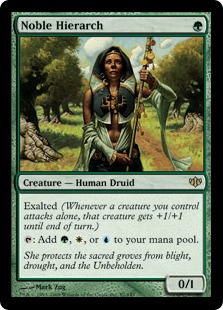 If the "Bolt Test" is the Lightning Bolt-related aphorism of Modern, "Bolt The Bird" is the Bolt-related saying for all Magic. Although in Modern, I'd probably rename it to "Bolt The Noble/Guide/Delver" these days. Almost any time you can use your Bolt to blow up a turn 1 play, that's a big win for you and a serious setback for your opponent. It's particularly important with manadorks, hence the origin of the phrase. Keeping your opponent from dropping turn 2 Lily or turn 3 Rhino is well-worth your one mana removal spell. Even in decks with lower curves, such as Infect, blowing up Noble Hierarch can keep the opponent off turn 2 Agent with one mana up for Vines of Vastwood. It's just as important for decks with consistent 1 drops, even if they aren't mana producers. This includes strategies like Burn (Swiftspear/Guide), Infect (Hierarch/Birds), and Zoo (Hierarch/Nacatl/E1). As with all rules, there will be exceptions to this, and only format and matchup experience will help you navigate this. But for the most part, Bolting the One-Drop is the right choice.
If the "Bolt Test" is the Lightning Bolt-related aphorism of Modern, "Bolt The Bird" is the Bolt-related saying for all Magic. Although in Modern, I'd probably rename it to "Bolt The Noble/Guide/Delver" these days. Almost any time you can use your Bolt to blow up a turn 1 play, that's a big win for you and a serious setback for your opponent. It's particularly important with manadorks, hence the origin of the phrase. Keeping your opponent from dropping turn 2 Lily or turn 3 Rhino is well-worth your one mana removal spell. Even in decks with lower curves, such as Infect, blowing up Noble Hierarch can keep the opponent off turn 2 Agent with one mana up for Vines of Vastwood. It's just as important for decks with consistent 1 drops, even if they aren't mana producers. This includes strategies like Burn (Swiftspear/Guide), Infect (Hierarch/Birds), and Zoo (Hierarch/Nacatl/E1). As with all rules, there will be exceptions to this, and only format and matchup experience will help you navigate this. But for the most part, Bolting the One-Drop is the right choice.
- CONTEXT 2: Creature toughness
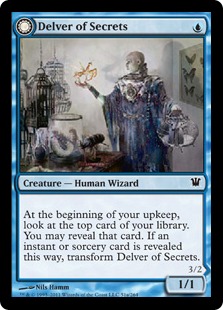 There is nothing inherently special about the number "3" in Modern. If Wizards started printing X/4s tomorrow en masse, Bolt would look a lot sillier. But with the cardpool what it is, a lot of decks rely on X/3s or smaller, particularly in early turns. So in a metagame with more relevant low-toughness targets, Bolt becomes strong. In a metagame where creatures are hardier, Bolt becomes weaker. Note you need to consider relevant low-toughness targets, not just any creature in the deck. Delver of Secrets and Signal Pest are relevant targets. Snapcaster Mage and a Spirit token are not. Neither is Slippery Bogle. Of course, this minimizes the importance of "3 damage" relative to player life totals, which is a more objective measure. But I'm going to touch on that in the final context about deck aggression. Context 2 is just about creature toughness because most decks aren't playing Bolt just to burn opponents. If they were, they would just use Lava Spike instead. They use Bolt primarily for removal, which is what Context 2 is all about.
There is nothing inherently special about the number "3" in Modern. If Wizards started printing X/4s tomorrow en masse, Bolt would look a lot sillier. But with the cardpool what it is, a lot of decks rely on X/3s or smaller, particularly in early turns. So in a metagame with more relevant low-toughness targets, Bolt becomes strong. In a metagame where creatures are hardier, Bolt becomes weaker. Note you need to consider relevant low-toughness targets, not just any creature in the deck. Delver of Secrets and Signal Pest are relevant targets. Snapcaster Mage and a Spirit token are not. Neither is Slippery Bogle. Of course, this minimizes the importance of "3 damage" relative to player life totals, which is a more objective measure. But I'm going to touch on that in the final context about deck aggression. Context 2 is just about creature toughness because most decks aren't playing Bolt just to burn opponents. If they were, they would just use Lava Spike instead. They use Bolt primarily for removal, which is what Context 2 is all about.
- CONTEXT 3: Aggro/fast combo prevalance
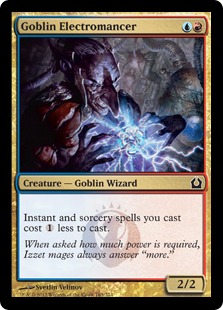 Bolt is at its best against decks relying on fast, aggressive creature drops to close out a game. This includes both more traditional aggro decks like Burn and Zoo, aggro/combo element decks like Infect and Affinity, and straight creature-based combo decks like Storm. Anything you can do to efficiently answer their threats early is time bought to get you to the later turns. In some cases, particularly with a threat like an Infect creature or Goblin Electromancer, Bolt can win the game outright if played at the right time. Even if you are playing an aggressive deck yourself, Bolt can give you a lifetotal or boardstate edge for you to get ahead. As a caveat, this won't include fast decks like Bogles, which ignores Bolt, or Amulet Bloom, which plays creatures too big for Bolt to hit.
Bolt is at its best against decks relying on fast, aggressive creature drops to close out a game. This includes both more traditional aggro decks like Burn and Zoo, aggro/combo element decks like Infect and Affinity, and straight creature-based combo decks like Storm. Anything you can do to efficiently answer their threats early is time bought to get you to the later turns. In some cases, particularly with a threat like an Infect creature or Goblin Electromancer, Bolt can win the game outright if played at the right time. Even if you are playing an aggressive deck yourself, Bolt can give you a lifetotal or boardstate edge for you to get ahead. As a caveat, this won't include fast decks like Bogles, which ignores Bolt, or Amulet Bloom, which plays creatures too big for Bolt to hit.
- CONTEXT 4: The importance of aggression
 So far, most of my contextual reasons have to do with creatures. But as we know, Bolt doesn't just target creatures. It also targets players and, in some Modern metagames, added aggression can be the deciding factor in a game. This is particularly true in metagames where decks rely on relatively dangerous manabases, where top-tier decks aren't using cards like Kitchen Finks and Lightning Helix, and where decks are too busy playing fair to race a deck with an aggressive stance. But the reverse is also true. When decks have relatively pain-free manabases, lots of maindecked means for blunting aggro, and are overall well-prepared for aggressive gameplans, then Bolt becomes a lot worse. To some extent, this is about knowing your deck's role in the metagame. When decks rely on Thoughtseize and fetchlands, going down to 15 life on turn 1, then aggression becomes much more relevant (and, by extension, Bolt too). But when you are playing against two-colored UW Control decks, Bolt is much worse.
So far, most of my contextual reasons have to do with creatures. But as we know, Bolt doesn't just target creatures. It also targets players and, in some Modern metagames, added aggression can be the deciding factor in a game. This is particularly true in metagames where decks rely on relatively dangerous manabases, where top-tier decks aren't using cards like Kitchen Finks and Lightning Helix, and where decks are too busy playing fair to race a deck with an aggressive stance. But the reverse is also true. When decks have relatively pain-free manabases, lots of maindecked means for blunting aggro, and are overall well-prepared for aggressive gameplans, then Bolt becomes a lot worse. To some extent, this is about knowing your deck's role in the metagame. When decks rely on Thoughtseize and fetchlands, going down to 15 life on turn 1, then aggression becomes much more relevant (and, by extension, Bolt too). But when you are playing against two-colored UW Control decks, Bolt is much worse.
In essence, when assessing Bolt's effectiveness in Modern, you are never really assessing the innate strengths of the card. Instead, you are looking at these four contextual points and seeing how Bolt interacts with them. These contexts also suggest situations where Bolt substitutes, like Path to Exile, might be good or bad in a particular month.
Are there other contexts we can consider in there? Absolutely! One notable example is the relevance of Red as a color. If Red is a good choice in Modern (e.g. Blood Moon or Terminate are strong cards), then Bolt becomes a bit better. If it stinks, Bolt will be worse just by extension. Another notable example is the opportunity cost of running Bolt over other cards. If you are running Bolt, you are running Red. If you are running Red, you probably aren't going four colors for Siege Rhino. Or if you are running Bolt in your Soul Sisters deck, you are now using fetchlands/shocklands in a deck that benefits from being monocolored. These are just two examples of the many other contexts we can think of for determining Bolt's metagame effectiveness.
That brings us to the more data-driven part of the article: applying these different contexts to the metagame data and trying to evaluate Bolt's effectiveness. This is the kind of mixed-methods approach I feel is very valuable in Magic. We have already used experience, theory, and qualitative observation to come up with a framework, and now it's time to plug in some values and run it through a quantitative test to see how it holds up in practice.
The "Lightning Bolt Index": A Metagame Comparison
If we are thinking about context to determine Bolt's effectiveness, there's no more important context than the Modern metagame. This means when assessing Bolt's context on those four counts above, we need to do so with respect to the top tier decks in the format. To do that, I'm going to look at all the tier 1 and tier 2 decks from our Top Decks page. These 21 decks represent about 75% of the overall metagame, and are themselves decks you would be most likely to face at any given event.
To establish some kind of "Bolt Index" for our current metagame, I'm going to rank all of those decks for each different context. I'm not a big fan of using semi-arbitrary ordinal rankings of 1-5 or 1-10 for stuff like this, because it's hard to say a 4 is really twice as good as a 2. It's particularly problematic if we eventually intend on combining those rankings into some weighted score for each deck, which we definitely do. So instead, I'm just going to use a binary system of 1s and 0s for each context. If the answer to the context-related questions below is "yes", then it gets a 1. If "no", then a 0.
- Does a deck 8+ one-drop creatures?
- Does a deck have at least 4 "relevant" creatures with 3 or less toughness?
- Is a deck an aggro, aggro/combo, or combo deck based on creatures? (Bogles doesn't count!)
- Does a deck have enough shocklands/fetchlands/life-losing spells that it is often at 15 life or less by turn 3 and < 4 maindeck lifegain cards?
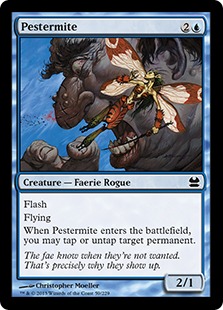 Of course, there is some subjectivity (even arbitrariness) in answering these questions and in setting some of the count cutoffs. But this is the sort of potential limitation we can minimize through transparency (i.e. just showing everyone how I ranked things) and through our own experiences with the different decks. This is also where we see some pitfalls to a binary system. For instance, even though Twin has legitimate targets, like Pestermite, Bolt isn't quite as good against Twin and its Exarchs/Skites as it is against Burn. But the binary values are much more useful in the final scoring, which I think is a good tradeoff for the absence of weight.
Of course, there is some subjectivity (even arbitrariness) in answering these questions and in setting some of the count cutoffs. But this is the sort of potential limitation we can minimize through transparency (i.e. just showing everyone how I ranked things) and through our own experiences with the different decks. This is also where we see some pitfalls to a binary system. For instance, even though Twin has legitimate targets, like Pestermite, Bolt isn't quite as good against Twin and its Exarchs/Skites as it is against Burn. But the binary values are much more useful in the final scoring, which I think is a good tradeoff for the absence of weight.
After I assign a deck a 1 or a 0 in each category, I tally their score and multiply it by the deck's prevalence. This give us a "Bolt Score" for each deck, the sum of which is the overall "Bolt Index" for the metagame. Let's see how this works with our current metagame, reflecting events from mid-March through the present. Again, this represents 21 decks comprising about 75% of the Modern metagame.
| Deck | Meta % | One-drop score | Toughness score | Speed score | Aggression score | TOTAL SCORE | Weighted score |
|---|---|---|---|---|---|---|---|
| Abzan | 11.5% | 0 | 1 | 0 | 1 | 2 | .23 |
| UR Twin | 10.5% | 0 | 1 | 0 | 0 | 1 | .11 |
| Burn | 9.7% | 1 | 1 | 1 | 0 | 3 | .29 |
| Affinity | 6.7% | 1 | 1 | 1 | 0 | 3 | .20 |
| Infect | 5.7% | 1 | 1 | 1 | 1 | 4 | .23 |
| Jund | 4.4% | 0 | 1 | 0 | 1 | 2 | .09 |
| Grixis Delver | 3.5% | 0 | 1 | 1 | 1 | 3 | .10 |
| RG Tron | 2.8% | 0 | 0 | 0 | 0 | 0 | .00 |
| Abzan Liege | 2.6% | 1 | 1 | 1 | 1 | 4 | .10 |
| Merfolk | 2.5% | 0 | 1 | 1 | 0 | 2 | .05 |
| Amulet Bloom | 2.4% | 0 | 0 | 0 | 0 | 0 | .00 |
| Scapeshift | 1.9% | 0 | 0 | 0 | 1 | 1 | .02 |
| Bogles | 1.8% | 0 | 1 | 0 | 0 | 1 | .02 |
| Grixis Twin | 1.8% | 0 | 1 | 0 | 1 | 2 | .04 |
| UWR Midrange | 1.8% | 0 | 1 | 0 | 0 | 1 | .02 |
| UWR Control | 1.6% | 0 | 0 | 0 | 0 | 0 | .00 |
| Blue Moon | 1.3% | 0 | 0 | 0 | 0 | 0 | .00 |
| Living End | 1.3% | 0 | 0 | 0 | 0 | 0 | .00 |
| RUG Twin | 1.3% | 0 | 1 | 0 | 1 | 2 | .03 |
| Naya Zoo | 1.2% | 1 | 1 | 1 | 0 | 3 | .04 |
| Esper Midrange | .8% | 0 | 1 | 0 | 1 | 2 | .02 |
Current Metagame Bolt Index: 1.57
This gives us a final number (1.52), but doesn't actually give us a point of reference for that final number. What exactly is a "good" score for Bolt? Is 1.52 high? Low? Average? How do we establish a reliable benchmark? One option is to assume a situation where every deck has a 1 in every category and then compare our number (1.52) to the theoretical value if every deck had a 1 (3.08). But that isn't contextual; it's just an absolute comparison. Maybe NO metagame will have a 3.08, so it isn't a realistic comparison. A better option is to just look at a metagame where we knew Bolt was pretty good, and then compare the score of that metagame to the score of our current one. To that end, I want us to look at the era of Treasure Cruise Delver and Pod. Bolt was not the best card in the world in this format, but it was still highly relevant and very strong. So we are going to want to compare Bolt's Index in that period with the 1.52 Index we just calculated for the current one. Although this only includes 17 decks instead of 21, it still made up about 75% of Modern at the time.
| Deck | Meta % | Dork score | Toughness score | Speed score | Aggression score | TOTAL SCORE | Weighted score |
|---|---|---|---|---|---|---|---|
| UR Delver | 14.2% | 0 | 1 | 1 | 0 | 2 | .28 |
| Melira Pod | 9.8% | 1 | 1 | 0 | 0 | 2 | .20 |
| Burn | 8.8% | 0 | 1 | 1 | 0 | 2 | .18 |
| Scapeshift | 7.5% | 0 | 0 | 0 | 1 | 1 | .07 |
| Affinity | 6.4% | 1 | 1 | 1 | 0 | 3 | .19 |
| Abzan | 3.5% | 0 | 1 | 0 | 1 | 2 | .07 |
| Merfolk | 3.4% | 0 | 1 | 1 | 0 | 2 | .07 |
| Bogles | 3.3% | 0 | 1 | 0 | 0 | 1 | .03 |
| Amulet Bloom | 3.1% | 0 | 1 | 0 | 0 | 0 | .00 |
| UR Twin | 2.5% | 0 | 1 | 0 | 0 | 1 | .02 |
| RUG Delver | 2.5% | 0 | 1 | 1 | 1 | 3 | .07 |
| UWR Control | 2.3% | 0 | 0 | 0 | 0 | 0 | .00 |
| Martyr Proc | 1.8% | 1 | 1 | 1 | 0 | 3 | .05 |
| UWR Ascendancy | 1.6% | 0 | 0 | 0 | 1 | 1 | .02 |
| Abzan Pod | 1.6% | 1 | 1 | 0 | 0 | 2 | .03 |
| UWR Midrange | 1.4% | 0 | 1 | 0 | 0 | 1 | .01 |
| Death and Taxes | 1.4% | 1 | 1 | 1 | 0 | 3 | .04 |
TC Delver/Pod Metagame Bolt Index: 1.62
Based on this, we would tentatively conclude Bolt is roughly as useful today as it was in the Delver/Pod metagame of October 2014 - January 2015. Given how popular Bolt was then, we would expect players to value Bolt almost as highly today. This means if you are deciding whether to play Abzan vs. Jund, or Esper Control vs. UWR Control, Bolt's relevance could sway your deck decision. It also means if you are playing a deck that is weak to Bolt (notably Infect), you shouldn't just expect to fly under the radar anymore.
Next Steps
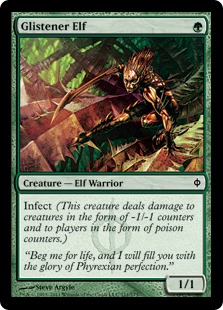 Naturally, there are all sorts of ways we can challenge these conclusions and expand our methods. We can tweak different cutoffs for the binary values (e.g. instead of 4 "relevant" creatures, 6-8 "relevant" creatures). We can also weight the binary values depending on how important they are with respect to the deck. For instance, even though both Infect and Abzan Liege scored a "1" in the "One-drop" column, it feels more important to blow up Infect one-drops than Abzan ones. There's only so much an unanswered Birds of Paradise can hurt you. But Glistener Elf threatens a turn 2-3 win. So we might give some kind of weight to the Infect score to account for this. Ultimately, there are lots of ways we can expand or refine this system, and this should mostly be treated as a jumpoff point for players looking to evaluate Bolt.
Naturally, there are all sorts of ways we can challenge these conclusions and expand our methods. We can tweak different cutoffs for the binary values (e.g. instead of 4 "relevant" creatures, 6-8 "relevant" creatures). We can also weight the binary values depending on how important they are with respect to the deck. For instance, even though both Infect and Abzan Liege scored a "1" in the "One-drop" column, it feels more important to blow up Infect one-drops than Abzan ones. There's only so much an unanswered Birds of Paradise can hurt you. But Glistener Elf threatens a turn 2-3 win. So we might give some kind of weight to the Infect score to account for this. Ultimately, there are lots of ways we can expand or refine this system, and this should mostly be treated as a jumpoff point for players looking to evaluate Bolt.
In the end, this is all just another way to use "data" (broadly speaking) to help you succeed in Modern. The Bolt Test will always be relevant in Modern, no matter what some subjective index might say, but sometimes it will be more or less relevant depending on the format. This system is just one way you can reach an objective valuation for Bolt in any given metagame, but feel free to modify and change as best fits your deckbuilding needs.
Finally, big shout out to MTGS user rickster_ and darksteel88 for brainstorming on this a while ago with me. I changed some stuff from our original methods, but wouldn't have had the inspiration for this without our initial conversations.


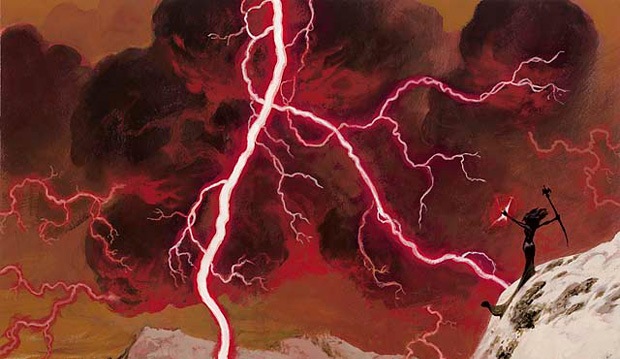




Good article. I’ve gone down to 3 bolts long ago and everyone has been calling me crazy. Replaced it with a pyroclasm and haven’t looked back. The games where bolt is good, pyroclasm is usually the nuts and can usually give me a 2 for 1 or better. Bolt just doesn’t kill enough these days to warrant the 4 of slot in my opinion.
3 seems very reasonable. You can also adjust the metagame prevalence column depending on whether you are playing mostly paper or mostly MTGO. The number look pretty different if we zoom in on one or the other instead of taking a pooled average. In fact, this is an interesting followup article idea I might do!
Interesting article, as always. I know a couple of people who were decrying Bolt as “dead”, and they very quickly had to eat their words. The poster above me makes a good point in that people should be running more sweepers than they do with as many linear aggro decks as there are in the Tier 1-2 slots, but I don’t believe that it should come at the expense of Bolt. If I’m running any red at all, that’s a 4-of (MB or SB) until someone proves otherwise.
Maybe I missed something but how can Abzan have a 1 in the one-drop score? Did you get the mixed up with Abzan Liege?
Whoops, just a data entry error. Too many 0s and 1s! It was correct in the second table, and I’ve fixed it in the first table. This doesn’t affect the numbers themselves because they were summed in a separate spreadsheet. It was just the 1 that is wrong. Thanks!
This is probably not the most relevant place to post this but I’d like you guys to have a more active metagame tracker like mtggoldfish. I totally understand mtggoldfish is mostly based on Dailies but I feel the monthly updates are more a reflection of where we were at that moment in time than where we are. Perhaps you maintain the monthly updates but then have a “trending meta” that takes the active month into consideration but perhaps at a lower “weight”. Also wouldn’t mind a visualized report of the T1-T2 decks that has a split bar sort of view showing the decks prevalence online vs paper.
Really this is just a recommendation as the meta is a living entity. Just looking at last months data isn’t going to prepare me to walk into a room full of Grixis Delver for example. However seeing where a meta was and that Grixis is trending in the face of that would really help me adjust my meta calls throughout the month.
Thanks for the feedback. Our Top Decks page is more or less as “live” as it gets. It’s updated daily, tracks the last 30-45 days of events, and even breaks off the decks into tiers and separate metagame percentages. Now, if this is a question about why we are using a spreadsheet and not a more robust database software, that’s different. We definitely want to get there eventually, but can’t really do so right now with our current resources. At least, not in the high quality way we would want to.
One option is to update the metagame table on the left navbar on a weekly, biweekly, or even daily basis. Is this more of the kind of thing you are suggesting?
Also, I should note that both the sidebar and the Top Decks page have definitely captured the Grixis Delver rise.
You know what happens when you assume…
I hadn’t really looked at it after your monthly article assuming it was just stagnant data. My bad!
No worries. I think we will add a note on the sidebar to make it clear that Top Decks is updated daily, just to make sure other users aren’t having the same issue.
Great article.
Bolt is also the only “1 for 3” spell in print that players can get to use in a realistic format (Modern, compared to Legacy / Vintage).
Many players initiation into their first few games of Magic was a lightning bolt to the face which either leave them slightly scarred or converted them forever to adopt red strategies. xD